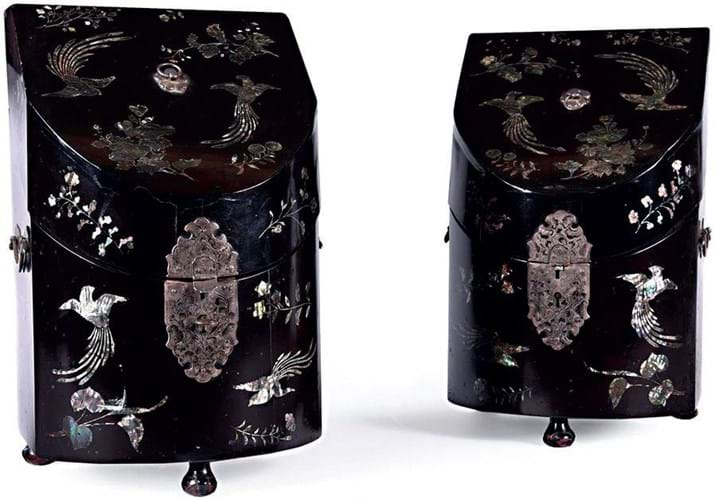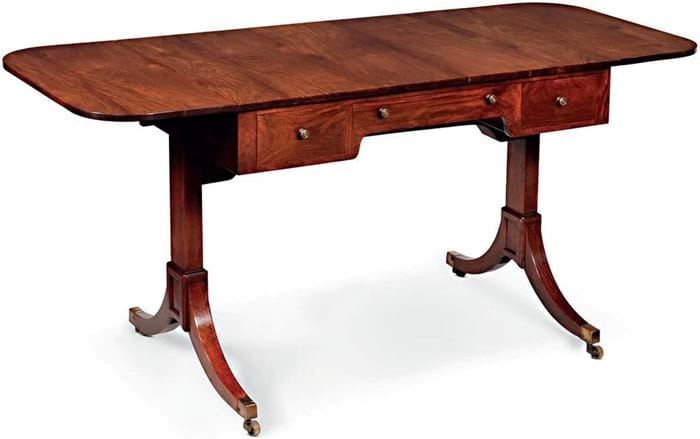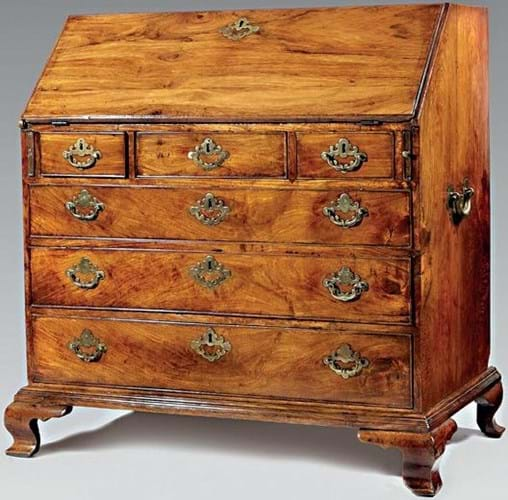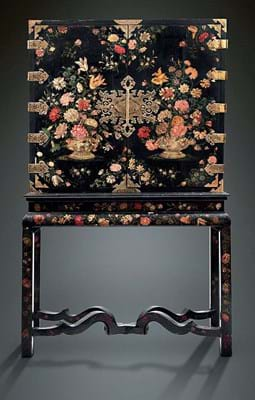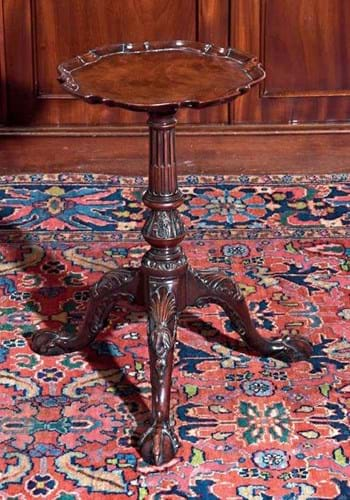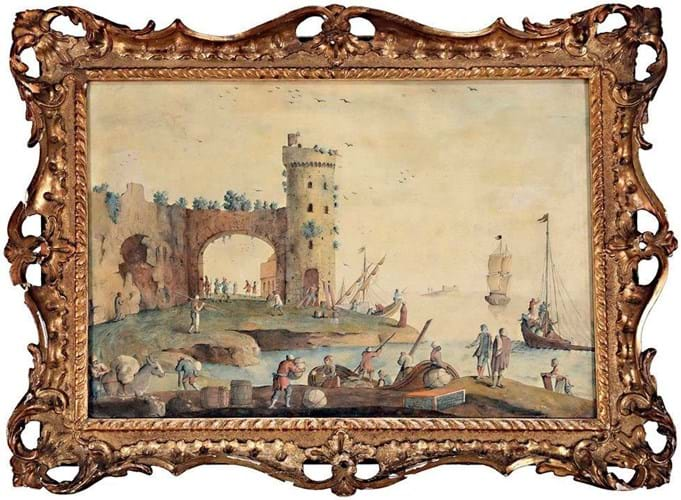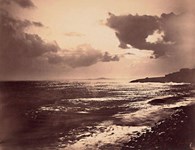In 1799 the Dutch East India Company’s chartered ship the Franklin of Salem arrived in Nagasaki on a trading mission.
The personal account books of the captain still survive and record that he brought back a considerable quantity of Japanese lacquer, all of it apparently made in contemporary European shapes. The shopping list included ‘22 lacked [sic] knife boxes’.
Some idea of the Franklin’s cargo was provided by the rare appearance at Dreweatts (25% buyer’s premium) on March 30-31 of a pair of slant-fronted cutlery boxes fashioned in black lacquer and mother-of-pearl set with pierced and engraved white metal hinges, clasps and handles.
Dated to c.1800, they were in largely original condition, retaining the matrix and green velvet lining to the interiors, with a few signs of old remedial work and touching up to the surface.
Only a handful of these are known in two classic Georgian models (pedestal urns and slanted front hinged boxes) and several different lacquer treatments. All are rarities.
Dreweatts pointed to a single example sold at Christie’s in December 2007 for £1750 as part of the collection of Giorgio Marsan and Umberta Nasi but a matching pair was in a different league.
Estimated at £2000-3000, they took £12,000.
Cultural exchange
Exoticism, and particularly the cross-culture objects provided by the exchange of ideas and materials in the Georgian period, is very much in fashion. China trade objects, in particular, attract significantly more interest today than the European forms they copied.
Some good examples of the Anglo- Chinese canon appeared both at Dreweatts and the equivalent auction of Furniture, Works of Art and Clocks held on March 30 by Woolley & Wallis (25% buyer’s premium).
All were made – probably in the workshops of Canton – in padouk and the auspicious fragranced ‘rosewood’ known as huanghuali common to much of the finest ‘classic’ Chinese furniture.
A huanghuali and padouk dropleaf games table sold for £9500 in Salisbury is comparable to two pictured in Carl Crossman’s The Decorative Arts of the China Trade (1999). All have similar interiors inlaid with boards for chequers and backgammon that, according to the author, was based on the design for a gaming box supplied by Thomas Chippendale for Paxton House in 1774. A similar table was sold by Dreweatts in June 2021 for £15,000.
Of seven late 18th and early 19th century drop leaf sofa tables offered at Newbury, the most eagerly contested was the export version in solid huanghuali from c.1810. Estimated at £4000-6000, it took £19,000 after competition between buyers at home and abroad.
In Salisbury a late 18th century Anglo-Chinese bureau, again in huanghuali and padouk, also made £19,000. Measuring 3ft 7in (1.07m) wide and made in two sections (it sits on a platform base with ogee bracket feet), some of the drawers are in ink with Chinese characters.
Chosen as the front cover illustration to the Woolley & Wallis sale was a William and Mary black and polychrome japanned cabinet on stand. In its form it is not unusual but the decoration to both elements of ‘still-life’ vases of flowers and floral sprays certainly is. Estimated at £8000-12,000, it took £55,000 – the top price of the sale.
It is one of a group of similar pieces, all painted with similar blooms, that include a cabinet at Christie’s New York in 2000 ($130,000) and another at Sotheby’s in 2007 (£32,000). It is unclear whether the ‘Dutch’ workshop that decorated them was based in London or in Holland.
Christie’s cabinet on a spectacular baroque giltwood stand was attributed by way of provenance to the Huguenot maker John Guilbaud (fl. 1691-1712) who worked at ‘The Crown & Looking-Glass’ in Long Acre, London.
There is still demand for the best ‘pure’ English work.

7. George III harewood and marquetry card table in the manner of Mayhew & Ince – £10,000 at Woolley & Wallis.
Another popular lot in the Salisbury sale (on view for the first time at the firm’s Old Sarum gallery – see News pages) was a George III harewood and marquetry card table in the manner of Mayhew & Ince. It included a frieze centred with a female blackamoor bust and the inlaid arms of William Masterman of Leyton.
Masterman (1759-1845) was a banker of Quaker origins who married Lydia (1756-1819), daughter of Daniel Mildred, a merchant of London. He purchased Leyton House from the Bertie family in 1788 which subsequently became Barclay Park. The banking firm of Masterman, Peters, Mildred and Masterman was based in Lombard Street, London, between 1779-1865.
In 2005, at a very different moment in the market for English furniture, a Pembroke table from the same suite that once belonged to the collector George D Widener Jr was sold by Christie’s New York for $140,000.
This card table was guided at £4000-6000 and sold at £10,000.
Dreweatts’ sale was topped by two online bids of £26,000; taken first by a particularly fine George II mahogany candlestand with a ‘pie crust’ moulded top.
A highly developed example of the form c.1750 – a table with similar carving to the stem is pictured in 18th Century English Furniture, The Norman Adams Collection (1983) – it came by family descent from Sir Harry Hague (1881-1960), managing director of A Wander Ltd.
The company is better known as the manufacturer of the chocolate malt drink Ovaltine, one of the most popular brands in Britain at the time of the Second World War. Hague invested the fortune he had amassed from Ovaltine in his art collection at his home The Chantry in Elstree, Hertfordshire, and employed the renowned furniture historian and connoisseur RW Symonds to advise him.
Much of his collection (each of the 80-plus pieces sold with RW Symonds ‘certificate of authenticity’) was sold by Sotheby’s in 1961 but this candlestand had been loaned to the National Trust since 1966. In generally good condition with an old shellac surface largely removed to reveal the well-figured timber beneath, it was estimated at £3000-5000.
Also sold at £26,000 (estimate £4000-6000) was a George I giltwood side or centre table of the type made in the 1720s by the London workshop of James Moore.
Dreweatts has offered several similar tables in recent sales: this one part of the consignment of property from the late Victoria, Lady de Rothschild. The auction house believed it to be of the period with evidence of later gesso and re-gilding.
Coming to auction with Danish royal provenance (it was originally in the collection of Prince Georg of Denmark) was a rare 18th century Florentine scagliola panel of an Italianate harbour scene. It was signed Lambertus Cristianus Gori, Fec: Florenze Anno Dom 1782 (or 1752) for Lamberto Cristiano Gori (1730- 1801), a leading exponent of the art of scagliola and apprentice to Don Enrico Hugford of Vallombrosa.
Unlike his master, who painted topographically specific views, Gori drew more on the painterly styles of artists such as Vernet and Pannini for imagined Mediterranean vistas. Similar scenes appear to a pair of table tops by Gori dated 1762 at Woburn Abbey (commissioned by the Marquess of Tavistock, eldest son of the 4th Duke of Bedford) and a pair of pictures offered as part of the collection of Prince and Princess Henry de la Tour d’Auvergne Lauraguais sold by Sotheby’s in 2012 for £22,000.
This single example, offered in a later frame, took £15,500.


